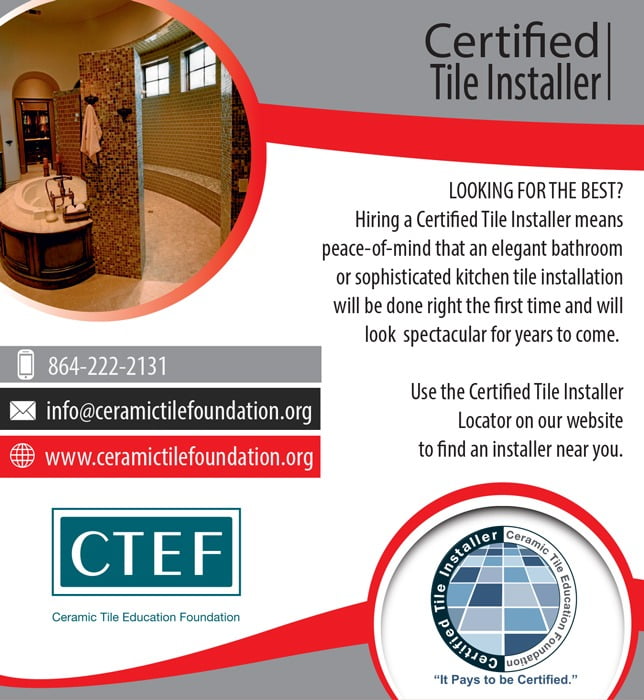Tile Tip
By Scott Carothers
Director of Certification and
Training for CTEF
One-Sided Thin Set is Not a Thing: How to Ensure a Proper Bond

The thin set mortar was not troweled properly and the mortar skinned over which didn’t allow the proper bond to the back of the tile. Notice that the lippage control devices provided a flat transition from tile to tile but did nothing to enhance the mortar bond to the tile. Photo: Scott Carothers.
Dry-set (thin-set) mortars are designed primarily to bond to the substrate and the back of the tile. Manufacturers work creatively to develop mortars that are easy to mix and place along with the ability to provide a tenacious bond. However, they do not make mortars that are one-sided, meaning they only bond to the tile or to the substrate. If the mortar bonds only to the substrate, many times the problem may be due to site conditions.
Case in point, recently an inquiry came in asking why the residential tile was loose and breaking. It was a four-year-old installation of large format plank tile on concrete using the direct bond method as found in the Tile Council of North America (TCNA) Handbook method F113, “On-Ground Concrete with Ceramic Tile.” The tile sounded hollow, the grout joints were cracked and crumbling, and numerous pieces of tile were broken.
When the loose tiles were removed, it revealed that the thin set was well bonded to the substrate with standing trowel notches that were not collapsed. Unfortunately, there was no transfer of the thin set mortar to the back of the tile. The question was, why didn’t the mortar bond to the tile? The answer could be attributed to one or more possibilities.

Xxx. Photo: Scott Carothers.
- If the concrete substrate was dry and porous when the thin set was applied, the moisture in the thin set would be drawn into the dry concrete causing the top surface of the thin set to dry prematurely. This situation can easily be corrected by dampening the substrate with water.
- Secondly, the thin set would rapidly lose moisture if the site was not climatized (windows and doors installed) with the HVAC system operational; wind or drafts blew across the thin set; or the HVAC system was operational allowing air movement across the floor.
- Thirdly, if the installer spread a large area of mortar, but did not install the tile quickly, normally fifteen to twenty minutes, the thin set would again lose moisture too rapidly. This last point is reinforced by the ANSI A108.5-2.2.2 which states in part, “Tile shall not be applied to skinned-over mortar.”
All three of these scenarios can cause what is commonly known as skinning. When the moisture leaves the mortar prematurely, the top surface of the spread mortar develops a film or skin which will not allow the mortar to transfer or bond to the back of the tile. In essence, the skin is a bond breaker to proper mortar transfer. To determine if the spread mortar is still bondable, place a finger into the mortar. If it transfers to your finger, you are good to go. If your finger comes up dry, the mortar is past its useful life. At this point, the mortar may be able to be re-troweled to expose the fresh mortar or if not, it should be removed and spread with fresh mortar. As the installation proceeds, the installer should occasionally check the condition of the thin set mortar to be sure it will function correctly.
The unhappy conclusion to the above inquiry is that the tile installation has failed and the tile industry gets another black eye. The tile and mortar must be removed, the substrate prepped as needed and new tile installed.



